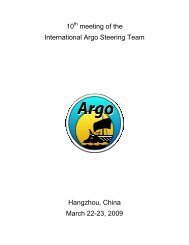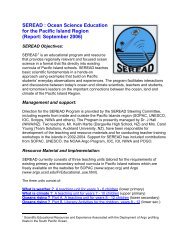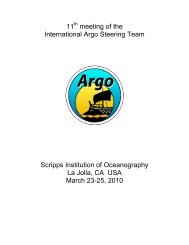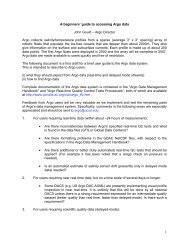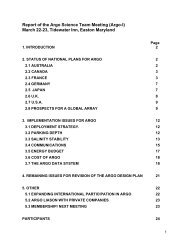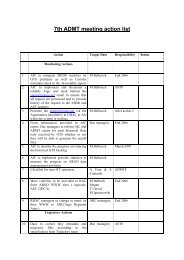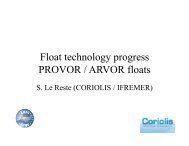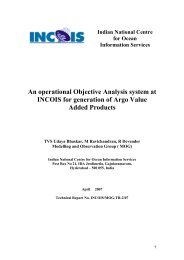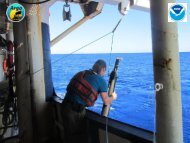AST-12 meeting report posted - Argo
AST-12 meeting report posted - Argo
AST-12 meeting report posted - Argo
Create successful ePaper yourself
Turn your PDF publications into a flip-book with our unique Google optimized e-Paper software.
Table 1. Delayed Mode processing statistics for the Australian array.<br />
The Australian <strong>Argo</strong> array continues to grow rapidly with an 18% increase in the total<br />
number of profiles delivered to the GDAC in the past quarter. A total of 399 floats have been<br />
deployed to date since the beginning of the <strong>Argo</strong> program and of these, 332 floats are still<br />
operational. As at 31/<strong>12</strong>/2010, 82% of eligible profiles (those that are greater than 6 months<br />
old) have been processed in delayed mode quality control.<br />
The re-write of the DMQC processing software is now largely complete and the integration<br />
of the SIO GIO and OW software is fully implemented. The next <strong>12</strong> months will see effort<br />
focusing on incorporating new formats, variables and multi-profile files into the DM process<br />
as well as trajectory files, oxygen data and delivery of <strong>Argo</strong> products.<br />
A total of 285 floats have been assessed through the DMQC process for drift of the salinity<br />
sensor. Of these, 6 floats (2 %) returned no data from deployment and 8 floats (3 %) returned<br />
bad data for the entire record due to pressure sensor issues or other hardware problems. Of<br />
the remaining 271 assessable floats, 235 (87 %) show no salinity drift for the life of the float.<br />
A further 33 or <strong>12</strong>% of floats show a positive salinity drift. These floats can be subdivided<br />
into those floats that drift gradually towards the end of life (18 floats or 7 %) and those that<br />
are salt offset from the start of the record (15 floats or 5 %). A small number of floats (3<br />
instruments or 1 %) are affected by a fresh offset or biofouling. Of the floats that are either<br />
salt or fresh offset, most were corrected using the OW salinity drift correction. 15 floats (5 %)<br />
suffered from TBTO fouling at the start of the record, generally only the first or second<br />
profiles but in some cases up to 7 profiles.<br />
2. Present level of and future prospects for national funding for<br />
<strong>Argo</strong><br />
<strong>Argo</strong> Australia has been part of Australian Government initiative: an Australian Integrated<br />
Marine Observing System (IMOS; www.imos.org.au) for research infrastructure funded<br />
under the National Collaborative Research Infrastructure Initiative (NCRIS) and now the<br />
Education Infrastructure Fund (EIF). EIF funding for <strong>Argo</strong> Australia is now secured through<br />
June 2013 and work is beginning on the follow-on.<br />
Through IMOS, and if levels of support from our partners remains steady, <strong>Argo</strong> Australia<br />
will sustain deployments of 50-60 floats per year and maintain an array of around 220-240<br />
active floats. However, longer float lifetimes may mean the standing array size could grow<br />
much larger. If this is the case, increased communication costs may require a slight reduction<br />
in the numbers of floats deployed in future years.<br />
3. Summary of deployment plans (level of commitment, areas of<br />
float deployment)<br />
We aim to deploy over 90 floats in 2011, most in the Indian and Southern Oceans, and some<br />
in the Pacific Ocean (Figure 2). We plan to lease the Lady Amber for many deployments in<br />
the Indian Ocean. However, we have had to modify plans to deploy in the northwestern<br />
sector due to the expanding activities of pirates in the region. Navy and very large container<br />
ships may be the only means of deploying floats into this dangerous region at present. On<br />
completion of her tour out of Fremantle, the Lady Amber may be available for follow-on<br />
leases by other <strong>Argo</strong> programs.<br />
47



